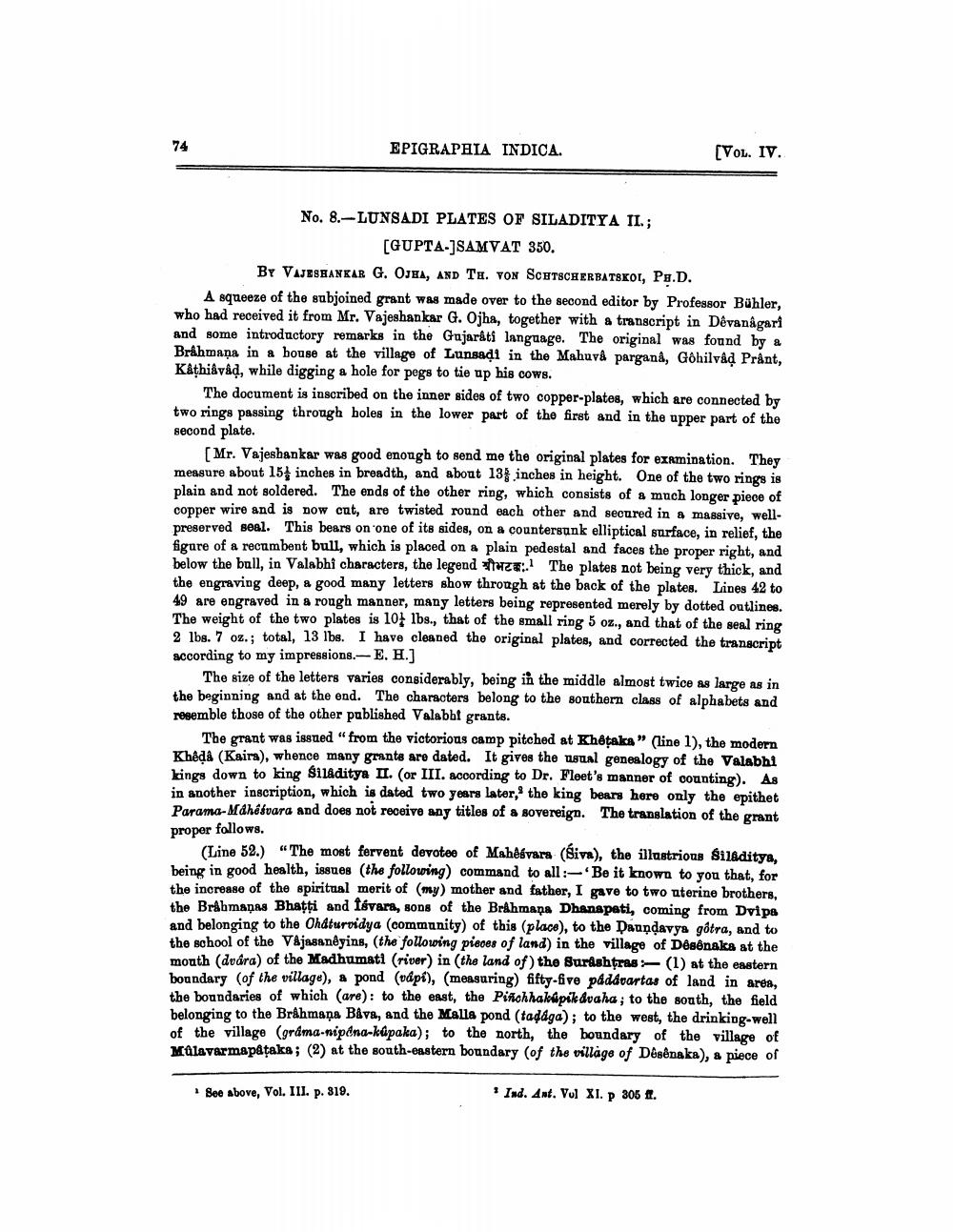________________
EPIGRAPHIA INDICA.
[VOL. IV.
No. 8.-LUNSADI PLATES OF SILADITYA II. ;
[GUPTA-]SAMVAT 350. BY VAJESHANKAR G. OJEA, AND TH. VON SCHTSCHERBATSKOT, Pg.D. A squeeze of the subjoined grant was made over to the second editor by Professor Bühler, who had received it from Mr. Vajeshankar G. Ojha, together with a transcript in Devanagari and some introductory remarks in the Gujarati language. The original was found by & Brahmaņa in a house at the village of Lunsadi in the Mahuva pargana, Gôhilvad Prant, Kathiávåą, while digging a hole for pegs to tie up his cows.
The document is inscribed on the inner sides of two copper-plates, which are connected by two rings passing through holes in the lower part of the first and in the upper part of the second plate.
[Mr. Vajeshankar was good enough to send me the original plates for examination. They measure about 15 inches in breadth, and about 13% inches in height. One of the two rings is plain and not soldered. The ends of the other ring, which consists of a much longer piece of copper wire and is now cut, are twisted round each other and secured in a massive, wellpreserved seal. This bears on one of its sides, on a countersunk elliptical surface, in relief, the figure of a recumbent bull, which is placed on a plain pedestal and faces the proper right, and below the bull, in Valabhi characters, the legend : The plates not being very thick, and the engraving deep, a good many letters show through at the back of the plates. Lines 42 to 49 are engraved in a rough manner, many letters being represented merely by dotted outlines. The weight of the two plates is 107 lbs., that of the small ring 5 oz., and that of the seal ring 2 lbs. 7 oz.; total, 13 lbs. I have cleaned the original plates, and corrected the transcript according to my impressions.-E. H.]
The size of the letters varies considerably, being in the middle almost twice as large as in the beginning and at the end. The characters belong to the southern class of alphabets and resemble those of the other published Valabbt grants.
The grant was issued "from the victorious camp pitched at Khotaka” (line 1), the modern Kheda (Kaira), whence many grants are dated. It gives the usual genealogy of the Valabhi kings down to king siladitya II. (or III. according to Dr. Floet's manner of counting). As in another inscription, which is dated two years later, the king bears here only the epithet Parama-Mahásvara and does not receive any titles of a sovereign. The translation of the grant proper follows.
(Line 52.) "The most fervent devotee of Mahébvara (Śiva), the illustrious siladitya, being in good health, issues (the following) command to all :- Be it known to you that, for the increase of the spiritual merit of (my) mother and father, I gave to two uterine brothers, the Brahmanas Bhatti and Isvara, sons of the Brahmana Dhanapati, coming from Dvipa and belonging to the Chaturvidya (community) of this place), to the Dauņdavys gôtra, and to the school of the Vajasan@yins, (the following pieces of land) in the village of Désênaks at the mouth (dvára) of the Madhumati (river) in the land of the Surishgras (1) at the eastern boundary of the village), a pond (väpi), (measuring) fifty-five påddvartas of land in area, the boundaries of which (are): to the east, the Pifchhakúpik dvaha; to the south, the field belonging to the Brahmaņa Bava, and the Malla pond (tadaga); to the west, the drinking-well of the village (grama-nipena-kúpaka); to the north, the boundary of the village of Mûlavarmapataka; (2) at the south-eastern boundary (of the village of Desênaka), a piece of
Soe above, Vol. III. p. 319.
Ind. Ant. Vol XI. p 305 .




